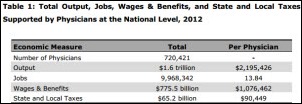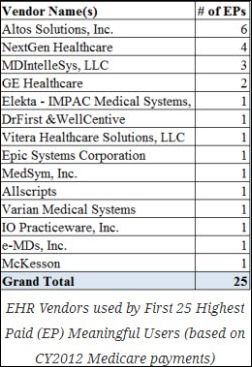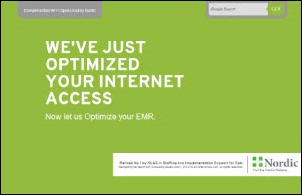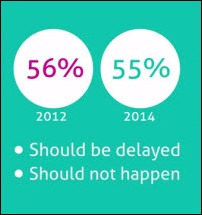The article about Pediatric Associates in CA has a nugget with a potentially outsized impact: the implication that VFC vaccines…
News 4/17/14
US physicians produced $1.6 trillion in direct and indirect economic advantage in 2012 and supported an average of more than 13 jobs apiece, according to an economic impact analysis by the American Medical Association. Some outside observers question the accuracy of those figures but there’s no denying that doctors make a big financial impact on the economy.
MHMD Memorial Hermann Physician Network (TX) will deploy DocbookMD’s mobile communication solution to connect its member physicians with one another and with other area providers.
Kids First Pediatrics Group (GA) integrates PatientPay’s electronic billing and payment solution with its Greenway PrimeSUITE practice management system.
EyeFormatics will bundle ZirMed’s RCM solutions within the EyeFormatics EMR.
Jacob Reider, MD, the ONC’s deputy national coordinator, will provide the keynote address at the 2014 Aprima User Conference in Dallas August 8-10.
Forget Weight Watchers, Jenny Craig, and pricey gym memberships. Boston doctors now have a new option to offer their low-income patients battling obesity: bike riding. The city’s “Prescribe-a-Bike” program allows doctors to write “prescriptions” for patients to buy a $5 yearlong membership to the city’s bike-share system. The list price is $85 for an annual membership.
I liked number crunching and data analysis, even when the final output doesn’t mean much. Case in point: Steven Posnack, who is director of the federal policy division for the ONC, posted on his personal blog some fun findings using details from the recently released Medicare payment data. He cross-referenced the payment data with MU payment data and determined what EHRs were used by the highest paid EPs (based on their Medicare payment data.) What does this tell us? Not a whole lot other than which systems are more commonly used in hematology/oncology, ophthalmology, and cardiology – the three specialties with the highest reimbursements. Altos is an oncology-specific EMR; NextGen and MDIntelleSys are widely used by ophthalmologists, and cardiologists use a variety of systems. Even though this chart doesn’t tell us a whole lot, Steve proved that provider details from multiple data sets can be linked – which may beget juicier output as people keep crunching the data.
Nordic Consulting begins a three-year sponsorship of the complimentary wireless Internet access at the Madison, WI airport. It’s definitely a clever marketing tool directed at all those Epic customers popping into town for training.
A systematic review study published in Perspectives in Health Information Management finds that e-prescribing in the ambulatory care setting improves patient safety, increases efficiencies, and saves money, but implementation costs, alert fatigue, and privacy/legal concerns remain barriers to adoption.
Florida is the latest state considering legislation changes to increase the use of telemedicine and establish requirements for providers who treat patients remotely. Proponents say that an expansion of telemedicine would reduce healthcare costs and improve patient access to physicians.
A NueMD ICD-10 survey conducted prior to the official delay shows that the majority healthcare professionals participating wanted the ICD-10 transition to be pushed back or canceled.
A review of clinical trials reveals that a doctor’s bedside manner can greatly improve patients’ health, aid weight loss efforts, lower blood pressure, or manage a painful symptom. Researchers found a “statistically significant” effect on outcomes when physicians had some sort of relationship-based training, such as building empathy and making eye-contact. I’m not sure I ever before realized how closely patient care parallels dating and marriage.
Email Inga.







